-
 Bitcoin
Bitcoin $107,631.9817
-1.73% -
 Ethereum
Ethereum $2,739.1787
-4.61% -
 Tether USDt
Tether USDt $1.0000
-0.01% -
 XRP
XRP $2.2427
-3.30% -
 BNB
BNB $664.0527
-0.73% -
 Solana
Solana $158.0902
-5.38% -
 USDC
USDC $0.9998
-0.01% -
 Dogecoin
Dogecoin $0.1876
-7.78% -
 TRON
TRON $0.2753
-3.21% -
 Cardano
Cardano $0.6820
-5.55% -
 Hyperliquid
Hyperliquid $43.0171
-0.38% -
 Sui
Sui $3.3308
-4.87% -
 Chainlink
Chainlink $14.3431
-7.89% -
 Avalanche
Avalanche $21.0266
-6.48% -
 Bitcoin Cash
Bitcoin Cash $437.7657
-1.56% -
 Stellar
Stellar $0.2746
-2.52% -
 UNUS SED LEO
UNUS SED LEO $8.8665
-1.96% -
 Toncoin
Toncoin $3.1885
-3.37% -
 Shiba Inu
Shiba Inu $0.0...01260
-6.84% -
 Hedera
Hedera $0.1686
-4.93% -
 Litecoin
Litecoin $88.8406
-5.16% -
 Polkadot
Polkadot $4.0542
-6.28% -
 Monero
Monero $322.5806
-4.20% -
 Ethena USDe
Ethena USDe $1.0004
-0.02% -
 Bitget Token
Bitget Token $4.7089
-3.10% -
 Dai
Dai $0.9998
-0.01% -
 Pepe
Pepe $0.0...01206
-9.06% -
 Uniswap
Uniswap $7.8694
-5.20% -
 Pi
Pi $0.6232
-2.68% -
 Aave
Aave $301.3815
-3.83%
Do the Bollinger Band breakthrough and the MACD golden cross resonate?
Bollinger Band breakthroughs and MACD golden crosses can enhance crypto trading by confirming trends and identifying entry/exit points, but use with caution due to potential false signals.
Jun 11, 2025 at 06:08 pm
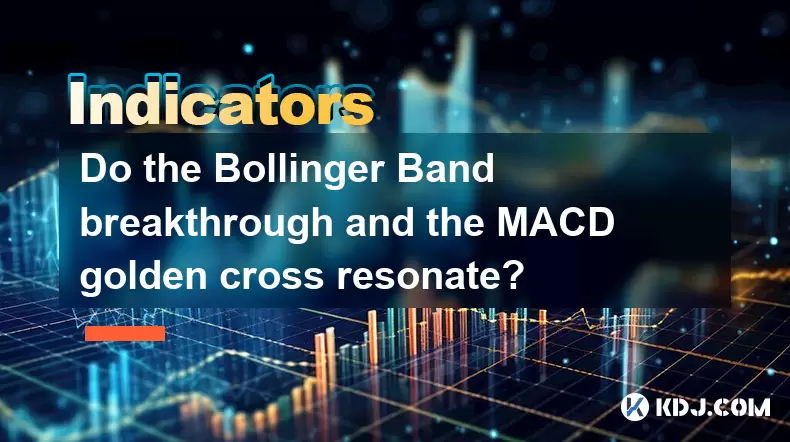
The interplay between technical indicators like the Bollinger Band breakthrough and the MACD golden cross can provide significant insights into market trends and potential trading opportunities within the cryptocurrency market. Both indicators are widely used by traders to identify momentum and potential reversals in price action. In this article, we will explore whether these two indicators resonate with each other and how they can be used together to enhance trading strategies.
Understanding the Bollinger Bands
Bollinger Bands are a volatility indicator developed by John Bollinger. They consist of three lines: a simple moving average (SMA) in the middle, and an upper and lower band that are typically set two standard deviations away from the SMA. The purpose of Bollinger Bands is to provide a relative definition of high and low prices and to identify periods of high and low volatility.
When a cryptocurrency's price moves outside the upper or lower band, it is considered a breakthrough. A breakthrough above the upper band often indicates that the price is overbought, while a breakthrough below the lower band suggests the price is oversold. Traders often look for these breakthroughs as potential signals for reversals or continuations in the price trend.
Understanding the MACD
The Moving Average Convergence Divergence (MACD) is a trend-following momentum indicator developed by Gerald Appel. The MACD is calculated by subtracting the 26-period exponential moving average (EMA) from the 12-period EMA. The result of this calculation is the MACD line. A signal line, which is a 9-period EMA of the MACD line, is then plotted on top of the MACD line.
A golden cross occurs when the MACD line crosses above the signal line, suggesting a bullish momentum and potential upward price movement. Conversely, a death cross happens when the MACD line crosses below the signal line, indicating bearish momentum and potential downward price movement.
The Resonance Between Bollinger Band Breakthrough and MACD Golden Cross
To understand whether the Bollinger Band breakthrough and the MACD golden cross resonate, we need to examine how these two indicators can complement each other in identifying trading opportunities.
Bullish Signals: A bullish signal from both indicators can provide a stronger confirmation of an upward trend. If a cryptocurrency's price breaks through the upper Bollinger Band and, simultaneously, the MACD line crosses above the signal line, it can be interpreted as a strong bullish signal. This combination suggests that the price is not only overbought but also gaining bullish momentum.
Bearish Signals: Similarly, a bearish signal from both indicators can reinforce the likelihood of a downward trend. If the price breaks through the lower Bollinger Band and the MACD line crosses below the signal line, it indicates that the price is oversold and losing momentum, potentially leading to further declines.
Divergence: Sometimes, the Bollinger Bands and MACD may provide conflicting signals. For instance, if the price breaks through the upper Bollinger Band but the MACD line does not cross above the signal line, it could indicate a false breakout. Traders should be cautious and look for additional confirmations before making trading decisions.
Using Both Indicators in a Trading Strategy
Combining the Bollinger Band breakthrough and the MACD golden cross in a trading strategy can enhance the accuracy of entry and exit points. Here’s how traders can integrate these indicators into their trading approach:
Identify Entry Points: Look for a bullish signal from both indicators to enter a long position. For example, if the price breaks through the upper Bollinger Band and the MACD line crosses above the signal line, it might be a good time to buy.
Identify Exit Points: Use bearish signals from both indicators to determine when to exit a long position or enter a short position. If the price breaks through the lower Bollinger Band and the MACD line crosses below the signal line, it could be a signal to sell or short the cryptocurrency.
Confirm Trends: Use the combination of these indicators to confirm trends. A consistent bullish signal from both indicators over time can confirm an uptrend, while consistent bearish signals can confirm a downtrend.
Practical Example in Cryptocurrency Trading
Let’s consider a practical example using Bitcoin (BTC) to illustrate how the Bollinger Band breakthrough and the MACD golden cross can be used together.
- Step 1: Open a charting platform that supports both Bollinger Bands and MACD indicators, such as TradingView or Binance.
- Step 2: Add the Bollinger Bands to the chart with the default settings (20-period SMA, 2 standard deviations).
- Step 3: Add the MACD indicator to the chart with the default settings (12, 26, 9).
- Step 4: Monitor the price action of Bitcoin. Look for instances where the price breaks through the upper Bollinger Band.
- Step 5: Simultaneously, watch for the MACD line to cross above the signal line.
- Step 6: If both signals occur at the same time, it might be a strong indication to buy Bitcoin.
- Step 7: Set a stop-loss order below the recent swing low to manage risk.
- Step 8: Monitor the indicators for bearish signals to determine when to exit the position. If the price breaks through the lower Bollinger Band and the MACD line crosses below the signal line, consider selling Bitcoin.
Limitations and Considerations
While the Bollinger Band breakthrough and the MACD golden cross can provide valuable insights, it is important to consider their limitations and use them in conjunction with other analysis methods.
- False Signals: Both indicators can produce false signals, especially in highly volatile markets. Traders should always use additional tools and analysis to confirm signals.
- Lag: Both indicators are based on historical data and can lag behind real-time price movements. This lag can result in missed opportunities or late entries.
- Market Conditions: The effectiveness of these indicators can vary depending on market conditions. In trending markets, they might be more reliable, while in ranging markets, they can generate more false signals.
Frequently Asked Questions
Q1: Can the Bollinger Band breakthrough and the MACD golden cross be used for short-term trading?
Yes, both indicators can be used for short-term trading. The Bollinger Band breakthrough can help identify short-term overbought and oversold conditions, while the MACD golden cross can signal short-term momentum shifts. However, traders should be aware of the increased risk and potential for false signals in short-term trading.
Q2: Are there other indicators that can be used in conjunction with the Bollinger Band and MACD?
Yes, traders often use other indicators to complement the Bollinger Band and MACD. Some popular choices include the Relative Strength Index (RSI), the Stochastic Oscillator, and volume indicators like the On-Balance Volume (OBV). These additional indicators can help confirm signals and provide a more comprehensive view of market conditions.
Q3: How can traders manage risk when using these indicators?
Traders can manage risk by setting stop-loss orders, using proper position sizing, and diversifying their trading portfolio. It is also important to monitor the indicators closely and adjust trading strategies based on market conditions and the performance of the indicators.
Q4: Can these indicators be used for all cryptocurrencies?
Yes, the Bollinger Band breakthrough and the MACD golden cross can be applied to all cryptocurrencies. However, the effectiveness of these indicators may vary depending on the liquidity and volatility of the specific cryptocurrency. Traders should backtest their strategies on different cryptocurrencies to understand their performance.
Disclaimer:info@kdj.com
The information provided is not trading advice. kdj.com does not assume any responsibility for any investments made based on the information provided in this article. Cryptocurrencies are highly volatile and it is highly recommended that you invest with caution after thorough research!
If you believe that the content used on this website infringes your copyright, please contact us immediately (info@kdj.com) and we will delete it promptly.
- The Bitcoin Treasury Strategy That's Reanimating Zombie Companies
- 2025-06-13 03:00:12
- BlockDAG (BDAG) Could Be the Next Biggest Altcoin as NBA Courtside Exposure Teases a Possible 2x Rally
- 2025-06-13 03:00:12
- Tether (USDT) Buys 32% Stake in Canada's Public Gold Royalty Firm Elemental Altus Royalties
- 2025-06-13 02:55:12
- Troller Cat Surges Past $225K in Presale as Dogwifhat Dips and FLOKI Gains
- 2025-06-13 02:55:12
- The graph (GRT), a key player in blockchain data indexing, has not seen a price pump yet.
- 2025-06-13 02:50:13
- Is This the Season Where Meme Coins Rewrite Crypto History Again?
- 2025-06-13 02:50:13
Related knowledge
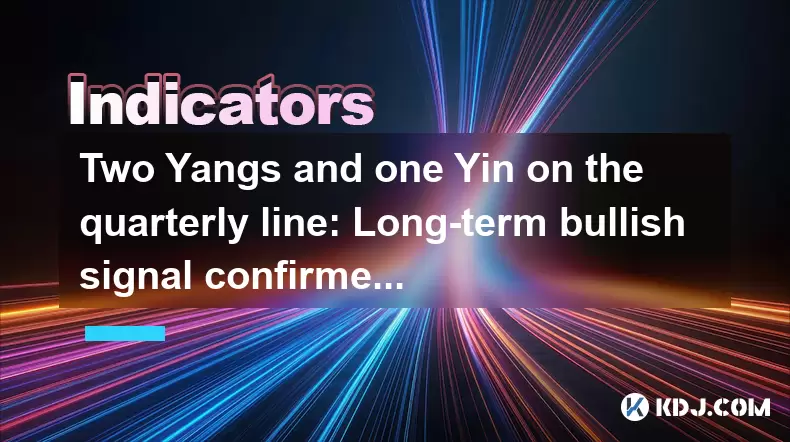
Two Yangs and one Yin on the quarterly line: Long-term bullish signal confirmed?
Jun 12,2025 at 07:00am
Understanding the 'Two Yangs and One Yin' Candlestick PatternIn technical analysis, candlestick patterns play a pivotal role in identifying potential market reversals or continuations. The 'Two Yangs and One Yin' pattern is one such formation that traders often observe on longer timeframes like the quarterly chart. This pattern consists of two bullish (...
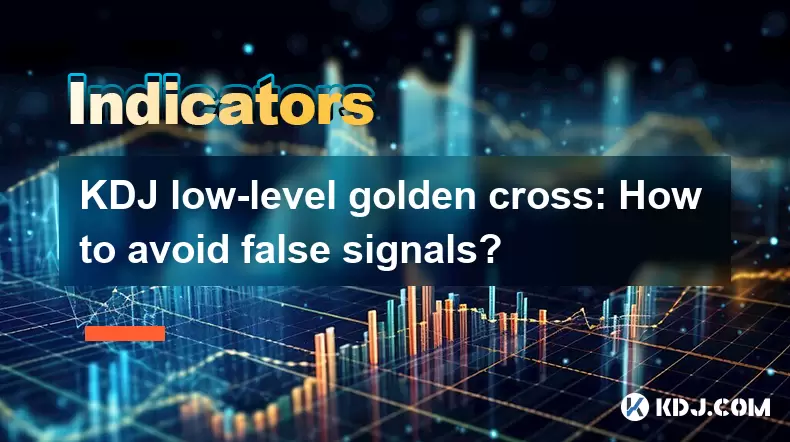
KDJ low-level golden cross: How to avoid false signals?
Jun 12,2025 at 08:21am
Understanding the KDJ IndicatorThe KDJ indicator, also known as the stochastic oscillator, is a momentum-based technical analysis tool widely used in cryptocurrency trading. It consists of three lines: the %K line (fast stochastic), the %D line (slow stochastic), and the %J line (divergence value). These lines oscillate between 0 and 100, helping trader...

Bottom-up volume stagnation: Is it accumulation or heavy selling pressure?
Jun 12,2025 at 01:42pm
What Is Bottom-Up Volume Stagnation?Bottom-up volume stagnation refers to a specific pattern observed in cryptocurrency trading charts where the price of an asset moves sideways or slightly downward, and trading volume remains consistently low over an extended period. This phenomenon is often seen after a sharp price drop or during a prolonged bear mark...
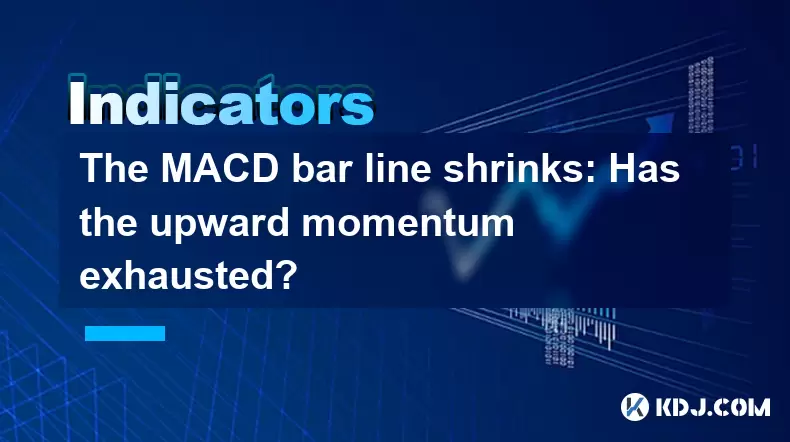
The MACD bar line shrinks: Has the upward momentum exhausted?
Jun 12,2025 at 12:49am
Understanding the MACD Bar LineThe Moving Average Convergence Divergence (MACD) is a widely used technical indicator in cryptocurrency trading. It consists of three main components: the MACD line, the signal line, and the MACD histogram (also known as the bar line). The MACD bar line represents the difference between the MACD line and the signal line. W...

The chip peak moves up: Is the main force quietly shipping?
Jun 12,2025 at 01:01am
Understanding the Chip Peak Movement in Cryptocurrency MiningIn recent years, the chip peak movement has become a critical topic within the cryptocurrency mining community. This phrase typically refers to the point at which mining hardware reaches its maximum efficiency and output capacity. When this peak shifts upward, it often signals changes in the s...
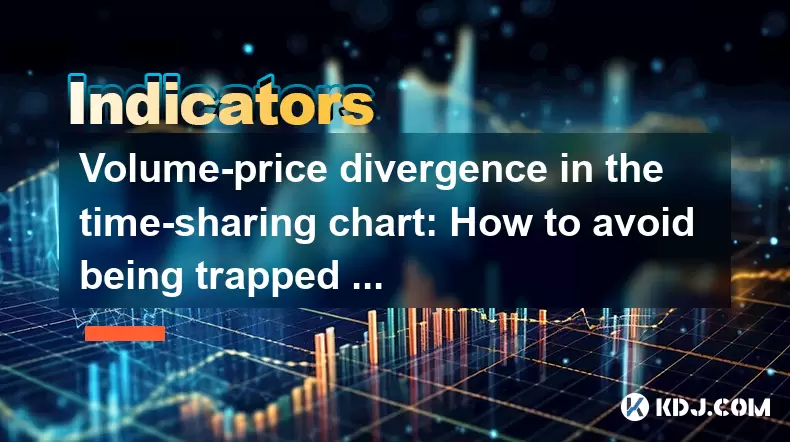
Volume-price divergence in the time-sharing chart: How to avoid being trapped on the same day?
Jun 12,2025 at 07:28pm
Understanding Volume-Price Divergence in Cryptocurrency TradingVolume-price divergence is a critical concept in technical analysis, especially within the fast-moving world of cryptocurrency trading. It refers to a situation where price movement and trading volume move in opposite directions. For instance, if the price of a cryptocurrency is rising while...

Two Yangs and one Yin on the quarterly line: Long-term bullish signal confirmed?
Jun 12,2025 at 07:00am
Understanding the 'Two Yangs and One Yin' Candlestick PatternIn technical analysis, candlestick patterns play a pivotal role in identifying potential market reversals or continuations. The 'Two Yangs and One Yin' pattern is one such formation that traders often observe on longer timeframes like the quarterly chart. This pattern consists of two bullish (...

KDJ low-level golden cross: How to avoid false signals?
Jun 12,2025 at 08:21am
Understanding the KDJ IndicatorThe KDJ indicator, also known as the stochastic oscillator, is a momentum-based technical analysis tool widely used in cryptocurrency trading. It consists of three lines: the %K line (fast stochastic), the %D line (slow stochastic), and the %J line (divergence value). These lines oscillate between 0 and 100, helping trader...

Bottom-up volume stagnation: Is it accumulation or heavy selling pressure?
Jun 12,2025 at 01:42pm
What Is Bottom-Up Volume Stagnation?Bottom-up volume stagnation refers to a specific pattern observed in cryptocurrency trading charts where the price of an asset moves sideways or slightly downward, and trading volume remains consistently low over an extended period. This phenomenon is often seen after a sharp price drop or during a prolonged bear mark...

The MACD bar line shrinks: Has the upward momentum exhausted?
Jun 12,2025 at 12:49am
Understanding the MACD Bar LineThe Moving Average Convergence Divergence (MACD) is a widely used technical indicator in cryptocurrency trading. It consists of three main components: the MACD line, the signal line, and the MACD histogram (also known as the bar line). The MACD bar line represents the difference between the MACD line and the signal line. W...

The chip peak moves up: Is the main force quietly shipping?
Jun 12,2025 at 01:01am
Understanding the Chip Peak Movement in Cryptocurrency MiningIn recent years, the chip peak movement has become a critical topic within the cryptocurrency mining community. This phrase typically refers to the point at which mining hardware reaches its maximum efficiency and output capacity. When this peak shifts upward, it often signals changes in the s...

Volume-price divergence in the time-sharing chart: How to avoid being trapped on the same day?
Jun 12,2025 at 07:28pm
Understanding Volume-Price Divergence in Cryptocurrency TradingVolume-price divergence is a critical concept in technical analysis, especially within the fast-moving world of cryptocurrency trading. It refers to a situation where price movement and trading volume move in opposite directions. For instance, if the price of a cryptocurrency is rising while...
See all articles

























































































